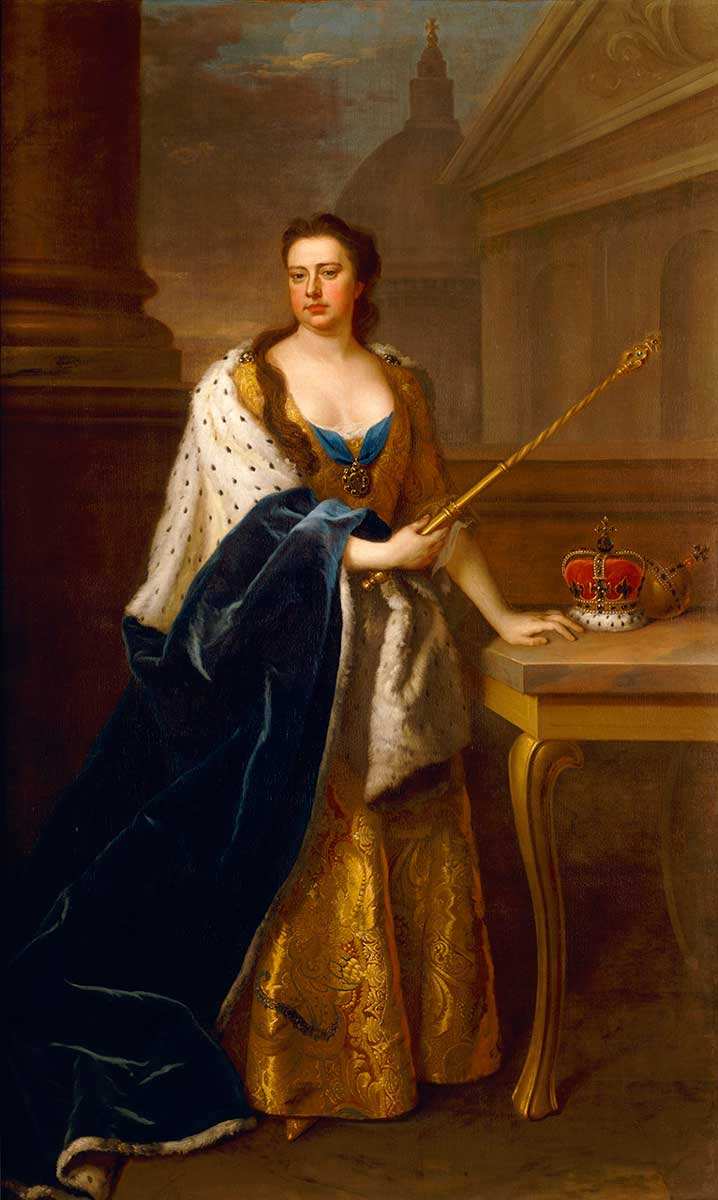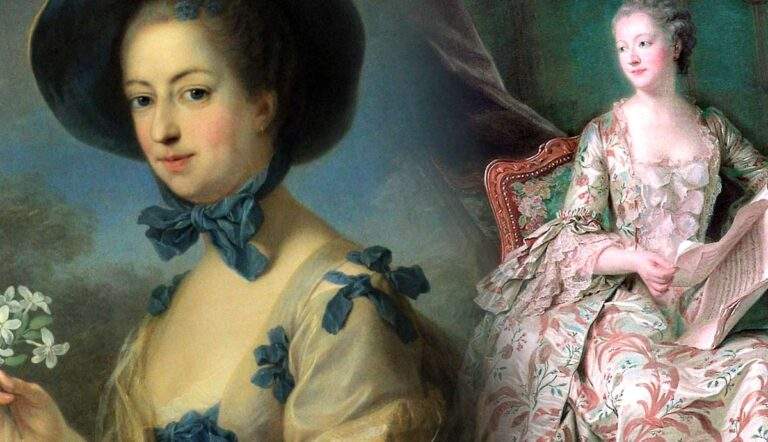
Due to the length of their reigns, three queens in British history tend to get the most attention: Queen Elizabeth I, Queen Victoria, and Queen Elizabeth II. This is understandable, but it does lead to other queens being overlooked.
Queen Anne is an obvious example. As the last of the Stuart monarchs, she reigned at the start of the eighteenth century from 1702 to 1714. Though her reign was an exciting time in British history – both at home and abroad – her personal life was wrought with tragedy from beginning to end.
Queen Anne’s Childhood

The girl who would become Queen Anne was born in St. James’s Palace, London, on February 6, 1665. She was the second daughter of the Duke of York, who became King James II in 1685.
Anne and her older sister Mary were the lucky ones. The other children born to the Duke and Duchess of York between 1660 and 1671 had an average lifespan of just twenty months. Yet, Anne could not escape her family’s unhealthy tendencies entirely. Her eyes suffered from defluxion, causing them to water and itch. Several months after her third birthday, Anne was moved closer to French eye doctors, staying at her grandmother’s home outside Paris.
Get the latest articles delivered to your inbox
Sign up to our Free Weekly Newsletter
While in France, Anne experienced some of her earliest tragedies. Within a couple of years, she lost her grandmother, her aunt, and her mother. This instilled a sense of uncertainty and insecurity, which she never fully overcame.
Now back in England, Anne received a less-than-ideal education alongside her sister Mary. (The social upheaval of the English Civil War and the Interregnum led to a general drop in education standards.) Domestic and artistic activities like sewing, embroidery, gardening, dancing, and playing music were prioritized, while subjects like history and geography were deemed less important. Neither of the sisters were particularly good at written English, either.
Religion, on the other hand, was a key part of the girls’ education. They were educated by Henry Compton, a Protestant who greatly opposed Catholicism and became Bishop of London in 1675. He laid the foundation for Anne’s loyalty and devout belief in the teachings of the Church of England.
Scandal & Pregnancy

When she was eighteen, Anne found herself at the center of a scandal with a notorious man called Lord Mulgrave, who was nicknamed the “Terror of Husbands.”
Gossip started to spread through London, with people claiming Mulgrave had seduced Anne, charming her with a series of letters and songs. There were even rumors he had slept with the princess, spoiling her for marriage. Both parties denied these allegations, and Mulgrave was sent into exile. (Historians now believe the rumors about Anne and Mulgrave were exaggerated.)
Anne’s marriage to Prince George of Denmark quelled the rumors for good. The couple married on July 28, 1683 at the Chapel Royal on the grounds of St. James’s Palace. Anne was showered with pearls and necklaces, and the couple also received a large spending allowance.
Despite having a good-natured husband, Anne’s married life was spoiled by one massive issue: the inability to have healthy children. Spending approximately thirteen years in various stages of pregnancy, Anne gave birth to fourteen stillborn babies, and only one of her children survived beyond infancy. Tragically, he was a weak boy and died from hydrocephalus at the age of eleven.
Anne’s poor health could likely have been the cause of her failed pregnancies. As well as being overweight, she suffered from gout and rheumatism.
King William, Queen Mary, & The Churchill Family

King James II tried to restore religious toleration for the Catholics during his reign. But this proved to be unpopular with both Parliament and the public, ultimately leading to the Glorious Revolution. William of Orange (Mary’s husband) landed in England in November 1688, and James was exiled to France.
The following year, William and Mary were crowned at Westminster Abbey, ruling jointly as Protestant monarchs. Anne, despite also being a Protestant, often quarreled with her sister and her Dutch husband.
Anne’s allowance became a point of contention. While she wanted an official state grant to be approved by Parliament, William wanted the allowance to come from his own income. Anne’s close friend Sarah Churchill exerted her influence over Parliament, leading to Anne gaining an annual income of £50,000. William and Mary did not approve, and their relationship with Anne and the Churchills continued to sour.
Though the deposed king failed to regain the crown at the Battle of the Boyne in July 1690, William and Mary were still worried they could be overthrown. Anne’s friendship with the Churchills could become a rallying point for those who opposed the new Dutch king. Indeed, Sarah’s husband, John Churchill (the Earl of Marlborough), was known to be in contact with James.
Whether Anne posed any genuine threat remains ambiguous. However, tensions continued to escalate until Marlborough was imprisoned in 1692 after a series of forgeries connecting him with a plot to overthrow the king. Though Marlborough was released from captivity, he did not return to his offices and remained isolated from the royal court.
The Reign of Queen Anne

Anne and Mary’s relationship never recovered. After the latter died of smallpox in December 1694, William remained in power for several more years before falling from his horse, suffering a series of health issues, and dying in March 1702.
The reign of Queen Anne had finally arrived, and with it came some religious reforms. In 1704, Queen Anne’s Bounty, a fund that supplemented the income for poorer members of the clergy, was introduced. Architects contributed to Christian culture by building places of worship. Christopher Wren designed St Paul’s Cathedral, which was completed in 1710. The following year, Parliament also passed an act proposing the construction of fifty new churches in London and Westminster.
The Act of Union in 1707, passed by the English and Scottish Parliaments, combined the Kingdom of England and the Kingdom of Scotland into one union: Great Britain. This changed Anne’s official title from the Queen of England to the Queen of Great Britain.

Anne’s reign is associated with the growth of coffee houses, which grew into centers for business and commerce. Indeed, overseas, capitalism grew generally throughout this period thanks to the increasing trade from America and Asia, sowing the seeds for the vast expansion of the British Empire.
Anne’s reign also overlapped with the War of the Spanish Succession, where Britain, Austria, Denmark, and the Netherlands sided against France, Spain, and Bavaria. The war eventually came to a close at the end of Anne’s reign with a series of peace treaties.
Marlborough (John Churchill) was a hero of the War of the Spanish Succession. He claimed a great victory at the Battle of Blenheim on August 13, 1704. Anne upgraded his title from an earl to a duke and gifted him an estate in Woodstock, near Oxford. Marlborough named his new home Blenheim Palace in honor of his victory.
Winston Churchill, the future Prime Minister, was born at this palace on November 30, 1874.
The Fall of Sarah Churchill & The End of Queen Anne

Despite Anne’s gratitude for Marlborough’s wartime success, her long-term friendship with Sarah started to deteriorate.
Politics was part of the problem. While the queen favored the Tories in Parliament, Sarah favored the Whigs. But there were personal issues, too. When Sarah’s cousin Abigail Masham joined the royal court, she became particularly close to Anne, displacing Sarah as the queen’s favorite. Sarah was eventually dismissed from her official duties in 1711.
Now nearing the end of her life, Anne still didn’t have a child to succeed her. Thankfully, the Act of Settlement in 1701 solved this issue. The act ensured the next monarch would be a Protestant by proposing that Princess Sophia, Electress of Hanover, would succeed to the throne when Anne died.
Given Sophia died before Anne did, the throne passed to her son George instead. This started the era of Hanoverian monarchs, which eventually ended with the death of Queen Victoria in 1901.
Anne, whose health had never been ideal, suffered even more in her final years due to her increasing size, making it difficult for her to move around. After suffering a stroke, she died in Kensington Palace, London, on August 1, 1714 at the age of forty-nine.
Queen Anne’s Legacy

Queen Anne’s life was loaded with tragedy. As a child, she became well acquainted with loss owing to the deaths of her grandmother, aunt, and mother.
The tragedies didn’t stop when she reached womanhood. Though pregnant for many years, she struggled with health issues and was unable to produce a healthy heir. Her only surviving child was weak and died long before he reached adulthood.
This was undoubtedly the most tragic part of Anne’s life. But the collapse of her relationships is also noteworthy. Despite being close to her sister Mary and her friend Sarah Churchill for many years, both these relationships turned sour.
However, as tragic as Anne’s personal life was, it’s important not to overlook the importance of her reign. Religious expansion, the development of overseas trade, Britain’s success during the War of the Spanish Succession, and the Act of Union shouldn’t be ignored.
Despite everything she went through in her personal life, Anne’s reign was an eventful and significant time in British history.








